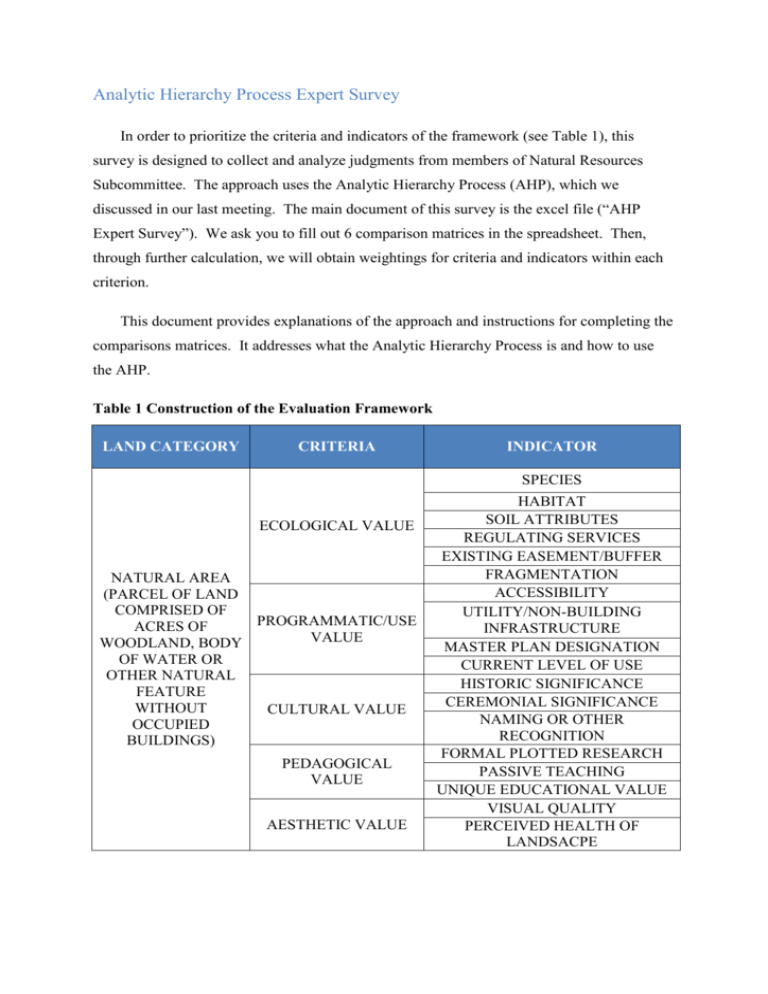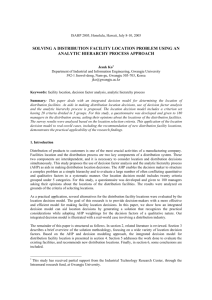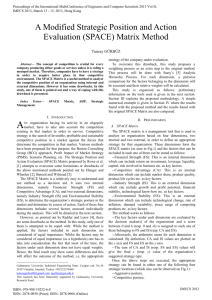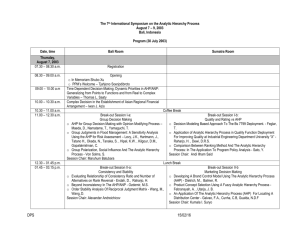AHP Expert Survey: Natural Resource Prioritization
advertisement

Analytic Hierarchy Process Expert Survey
In order to prioritize the criteria and indicators of the framework (see Table 1), this
survey is designed to collect and analyze judgments from members of Natural Resources
Subcommittee. The approach uses the Analytic Hierarchy Process (AHP), which we
discussed in our last meeting. The main document of this survey is the excel file (“AHP
Expert Survey”). We ask you to fill out 6 comparison matrices in the spreadsheet. Then,
through further calculation, we will obtain weightings for criteria and indicators within each
criterion.
This document provides explanations of the approach and instructions for completing the
comparisons matrices. It addresses what the Analytic Hierarchy Process is and how to use
the AHP.
Table 1 Construction of the Evaluation Framework
LAND CATEGORY
CRITERIA
INDICATOR
SPECIES
ECOLOGICAL VALUE
NATURAL AREA
(PARCEL OF LAND
COMPRISED OF
PROGRAMMATIC/USE
ACRES OF
VALUE
WOODLAND, BODY
OF WATER OR
OTHER NATURAL
FEATURE
WITHOUT
CULTURAL VALUE
OCCUPIED
BUILDINGS)
PEDAGOGICAL
VALUE
AESTHETIC VALUE
HABITAT
SOIL ATTRIBUTES
REGULATING SERVICES
EXISTING EASEMENT/BUFFER
FRAGMENTATION
ACCESSIBILITY
UTILITY/NON-BUILDING
INFRASTRUCTURE
MASTER PLAN DESIGNATION
CURRENT LEVEL OF USE
HISTORIC SIGNIFICANCE
CEREMONIAL SIGNIFICANCE
NAMING OR OTHER
RECOGNITION
FORMAL PLOTTED RESEARCH
PASSIVE TEACHING
UNIQUE EDUCATIONAL VALUE
VISUAL QUALITY
PERCEIVED HEALTH OF
LANDSACPE
What is Analytic Hierarchy Process?
Analytic Hierarchy Process (AHP) is a multi-criteria decision making method,
originally developed by mathematician Thomas L. Saaty, and is a tool with numerous
applications in areas of planning and management (Saaty T. L., 1980). It can be used for
evaluations of different problems in urban landscape management (Li, 2005) (Srdjevic,
Lakicevic, & Srdjevic, 2013) (Kim & Sato, 2000). AHP uses a pairwise comparison method
to generate weightings (ratio scales) for criteria, instead of simply listing and ranking the
levels of importance.
How to use the AHP?
Step One: Construction of Pairwise Comparison Matrices
Pairwise comparisons are used to determine the relative importance of each criterion.
Available values for the pairwise comparisons are members of the set: {9, 8, 7, 6, 5, 4, 3, 2, 1,
1/2, 1/3, 1/4, 1/5, 1/6, 1/7, 1/8, 1/9}. The pairwise comparisons are arranged in a matrix. The
following section uses an illustrative example to explain how to fill in the pairwise
comparison matrix.
Table 2 The Fundamental Scale for Pairwise Comparisons
Note: Element a and b are any two of the criteria.
Intensity of
Importance
1
3
5
7
Definition
Explanation
Equal importance
Element a and b contribute equally to the objective
Moderate importance
of one over another
Essential importance
Demonstrated
importance
Slightly favor element a over b
Strongly favor element a over b
Element a is favored very strongly over b
9
Absolute importance
Intermediate values
2, 4, 6, 8
between the two
adjacent judgments
The evidence favoring element over a over b is of the
highest possible order of importance
When compromise is needed. For example, 4 can be used
for the intermediate value between 3 and 5
1/3, 1/4 ,
These values represent the opposite of the reciprocal whole numbers. For example,
1/5, 1/6, 1/7, if "9" means that x is much more important than y, "1/9" means that x is much less
1/8, 1/9
important than y.
An illustrative example1
Suppose there are five criteria for a citizen to consider when choosing a mode of
transportation (private cars, buses, or subways):
Convenience: Are the transportation tools easy to access? (Is the parking lot near the
apartments? Is bus station near the destination? Etc.)
Comfort: Do people feel comfortable when they are in the transportation tools?
Expense: Do people spend much money on transportation (tickets, fuels, etc.)?
Time: Do the transportation tools waste/save time (low speed, traffic jam, etc)?
Environmental effects: Do the transportation tools have any negative environmental
effects?
Pairwise comparisons are used to reveal people’s preferences on these five criteria when
they choose the ways of transportation. An empty template of the matrix is in Table 4.
People need to compare these criteria from blue cells to green cells. (i.e. is the item in the
blue cell more important, less important, or equal to the item in the green cell). Only the
orange cells need to be filled. The white cells are the reciprocal values of the associated
orange cells. The gray cells are all blank because, for example, “convenience” cannot be
more or less important than itself.
In the cell marked “A” (in table 4 below), the respondent would need to decide if
convenience is more important, as important, or less important than comfort. So, if they think
convenience is slightly more important than comfort, they would put a number like 3 or 4 in
1
The information and data are retrieved from a real study conducted by Siying Li.
the cell. However, if they think that convenience is slightly less important than comfort they
would put in numbers like 1/3 or 1/4.
The important thing to remember is that the respondent must fill in the orange cells by
comparing the importance of the blue column to the green row, not the other way around.
Table 4 The Pairwise Comparison Matrix Template
Criteria
Convenience
Convenience
Comfort
Expense
Time
Environmental
effects
A
Comfort
Expense
Time
Environmental
effects
Calculating the weightings
**You do not need to read this in order to fill out the table. We are only providing this
for those people interested in the math behind the process**
The next step is to estimate the principal eigenvector of the pairwise matrix (Saaty T. L.,
1990) (Saaty T. L., 1980) (Triantaphyllou & Mann, 1995). First, we used geometric mean
calculation to combine the four individual pairwise comparison matrices collected from four
experts. That is, the elements in each row in each individual matrix are multiplied with each
other, and it is a product matrix. Then we take the n-th root of the product matrix of row
elements (where n is the number of elements in the row). Next, by dividing them with the
column sum of them, the numbers are normalized. Then, through further calculation, we will
obtain a principal eigenvector of the pairwise comparison matrix. It is a vector of priorities in
ratio scales and is just the weightings for criteria.
Furthermore, the AHP approach has a consistency test. The pairwise comparisons are
considered to be adequately consistent if the corresponding consistency ratio (CR) is less than
10% (Saaty T. L., 1980). First, estimate the consistency index (CI), by adding the columns in
the pairwise comparison matrix and multiply the resulting vector by the vector of priorities
(i.e., the approximated eigenvector) obtained earlier. This yields an approximation of the
maximum eigenvalue, denoted by 𝜆𝑚𝑎𝑥 . Then, the CI value is calculated by using the
formula: CI = (𝜆𝑚𝑎𝑥 - n)/(n - 1)2. Next the consistency ratio CR is obtained by dividing the
CI value by the Random Consistency Index (RI) as given in table 3. (Triantaphyllou & Mann,
1995)
Table 3 Random Consistency Index Refer Table
Number of
Criteria
1
2
3
4
5
6
7
8
9
10
11
RI
0
0
0.58
0.9
1.12
1.24
1.32
1.41
1.45
1.49
1.51
Works Cited
Kim, K., & Sato, S. (2000). Evaluation of Urban Landscape Problem Using Analytic
Hierarchy Process Method. Computing in Civil and Building Engineering , 442-448.
Li, K.-l. (2005). Using analytic hierarchy process in urban road landscape evaluation.
Journal of Wuhan University of Hydraulic and Electric Engineering , 1.
Saaty, T. L. (1990). How to make a decision: the analytic hierarchy process. European
journal of operational research , 48 (1), 9-26.
Saaty, T. L. (1980). The analytic hierarchy process : planning, priority setting, resource
allocation. Mcgraw-Hill.
Srdjevic, Z., Lakicevic, M., & Srdjevic, B. (2013). Approach of decision making based on
the analytic hierarchy process for urban landscape management. Environmental
management , 51 (3), 777-785.
2
“n” is the number of criteria in the matrix.
Triantaphyllou, E., & Mann, S. H. (1995). Using the analytic hierarchy process for
decision making in engineering applications: some challenges. . International
Journal of Industrial Engineering: Applications and Practice , 2 (1), 35-44.











